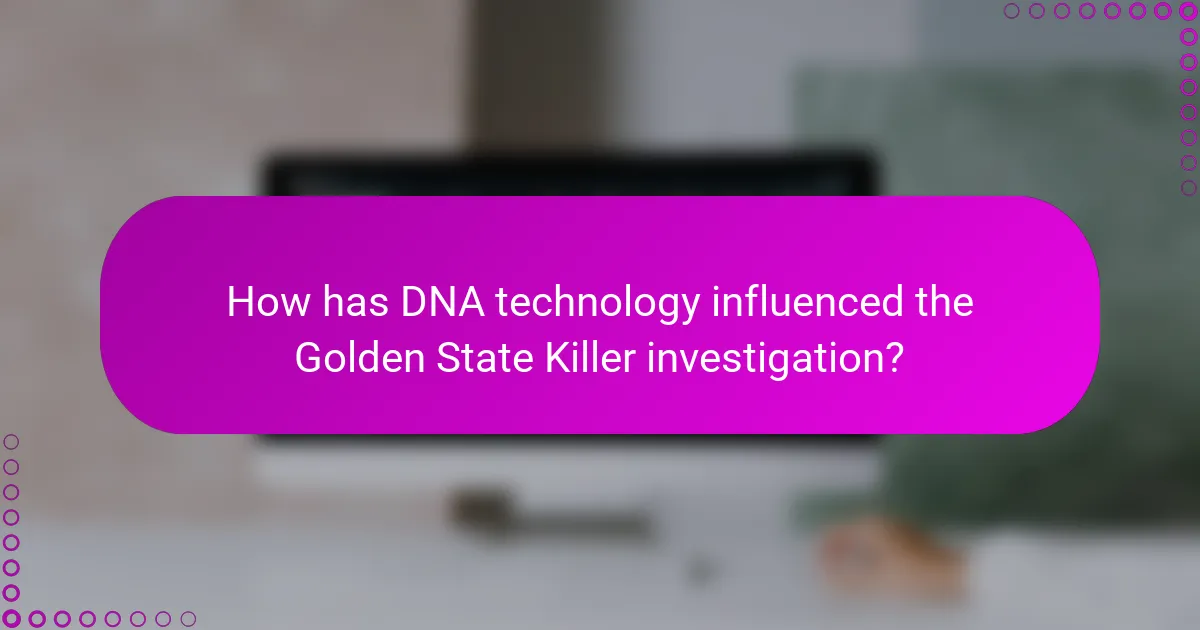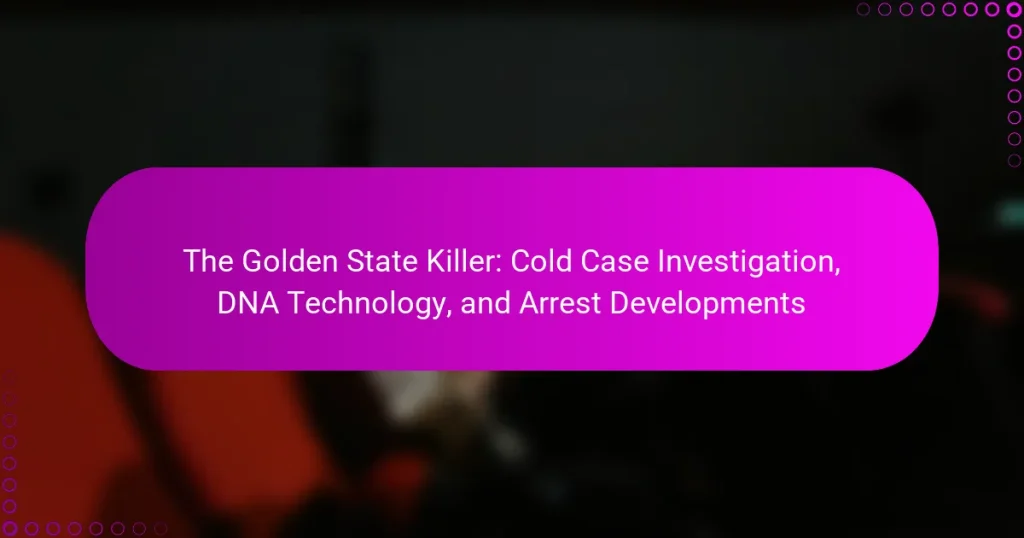The Golden State Killer case involves a series of crimes in California from 1976 to 1986, attributed to an unidentified individual linked to 13 murders, over 50 rapes, and various burglaries. The case remained unsolved for decades until advancements in DNA technology led to the identification and arrest of Joseph James DeAngelo in 2018 through genetic genealogy techniques. Following his arrest, DeAngelo was sentenced to life in prison without parole in August 2020 after pleading guilty to multiple charges. The case exemplifies the significant role of DNA evidence in solving cold cases and has prompted discussions regarding criminal justice reform and the ethical use of DNA databases. Ongoing analysis of DNA evidence continues to influence forensic technology and cold case investigations nationwide.

What is the Golden State Killer case?
The Golden State Killer case refers to a series of crimes committed by an unidentified individual in California between 1976 and 1986. This perpetrator is linked to at least 13 murders, over 50 rapes, and numerous burglaries. The case remained unsolved for decades, becoming one of America’s most notorious cold cases. Advances in DNA technology eventually led to the identification of Joseph James DeAngelo as the suspect in 2018. His arrest was made possible through genetic genealogy techniques that matched DNA from crime scenes to distant relatives. The Golden State Killer case highlights the challenges and advancements in criminal investigations over time.
How did the Golden State Killer become a notorious figure in criminal history?
The Golden State Killer became a notorious figure in criminal history due to a series of violent crimes committed in California between 1976 and 1986. He is responsible for at least 13 murders, over 50 rapes, and numerous burglaries. His ability to evade capture for decades contributed to his infamy. The case remained unsolved for years, leading to widespread media coverage and public fascination. Advances in DNA technology eventually linked him to the crimes. In 2018, Joseph James DeAngelo was arrested as the suspect, confirming his identity through genetic genealogy. His case exemplifies the challenges of cold cases and the impact of modern forensic science.
What were the key crimes attributed to the Golden State Killer?
The key crimes attributed to the Golden State Killer include multiple counts of murder, [censured] assault, and burglary. He is linked to at least 13 murders across California from 1976 to 1986. The killer also committed over 50 [censured] assaults during this time period. His crime spree involved home invasions where victims were often tied up. In addition to these violent acts, he is associated with numerous burglaries. The Golden State Killer’s identity was confirmed through DNA evidence in 2018. This evidence connected him to various crime scenes, solidifying his culpability in these heinous acts.
How did the media coverage impact public perception of the case?
Media coverage significantly shaped public perception of the Golden State Killer case. Extensive reporting brought national attention to the cold case. This heightened awareness led to increased public interest and involvement. Many individuals shared tips and information with law enforcement. The media’s portrayal emphasized the urgency of solving the case. This created a sense of community engagement and responsibility. Additionally, coverage highlighted advancements in DNA technology that played a crucial role in the investigation. The media’s focus on these developments fostered hope for resolution among the public.
What role did cold case investigations play in this case?
Cold case investigations were crucial in solving the Golden State Killer case. They allowed law enforcement to revisit unsolved crimes with fresh eyes. Investigators utilized advancements in DNA technology to analyze evidence from the original cases. This led to the identification of suspect Joseph DeAngelo in 2018. The cold case approach helped to connect multiple crimes across different jurisdictions. It also reignited public interest and support for the investigation. These efforts ultimately resulted in a significant breakthrough in a decades-old case.
How are cold cases typically investigated?
Cold cases are typically investigated through a combination of reviewing existing evidence and utilizing new technology. Investigators start by re-examining case files, witness statements, and physical evidence. They look for overlooked details or inconsistencies that may provide new leads. Advances in DNA technology play a crucial role in solving cold cases. For example, forensic DNA analysis can re-test old evidence for new DNA profiles. Additionally, investigators may collaborate with genealogists to trace familial connections. Public appeals for information can also generate new tips from the community. Each of these methods aims to uncover new information that could lead to solving the case.
What challenges do investigators face in cold case investigations?
Investigators face several challenges in cold case investigations. One significant challenge is the lack of physical evidence due to the passage of time. Many cold cases have degraded evidence or missing materials. Witnesses may forget details or become unavailable. This can hinder the ability to gather new testimonies. Additionally, investigators often deal with outdated technology that may not yield results. Advances in forensic science can help, but not all evidence is suitable for new techniques. There is also a limited budget and resources allocated for cold cases. This can restrict the number of cases that can be actively pursued. Finally, the emotional toll on families and investigators can complicate the process. These factors collectively make solving cold cases particularly difficult.

How has DNA technology influenced the Golden State Killer investigation?
DNA technology significantly influenced the Golden State Killer investigation by enabling the identification of the suspect through genetic genealogy. Investigators utilized DNA samples collected from crime scenes. These samples were compared against genetic databases. The breakthrough came when they found a match with distant relatives of the suspect. This method led to the identification of Joseph James DeAngelo in 2018. His arrest was made possible by the analysis of DNA from a discarded item linked to him. The application of this technology turned a decades-old cold case into a solvable investigation. DNA technology has since become a crucial tool in solving cold cases nationwide.
What advances in DNA technology were utilized in this case?
In the case of the Golden State Killer, advances in DNA technology included the use of genetic genealogy. This method allowed investigators to compare DNA samples from crime scenes with public DNA databases. The process identified distant relatives of the suspect through their genetic markers. Investigators then built family trees to narrow down potential suspects. Additionally, forensic DNA analysis enabled the extraction of DNA from degraded samples. This combination of techniques led to the arrest of Joseph James DeAngelo in 2018. The successful application of these technologies marked a significant breakthrough in solving cold cases.
How does DNA profiling work in criminal investigations?
DNA profiling works by analyzing an individual’s unique genetic material to identify them. In criminal investigations, biological samples like blood, hair, or saliva are collected from crime scenes. These samples contain DNA, which is extracted and amplified using techniques like Polymerase Chain Reaction (PCR). The amplified DNA is then compared to DNA profiles in databases.
Each individual’s DNA has specific patterns that are unique, known as short tandem repeats (STRs). Forensic scientists analyze these STRs to create a DNA profile. This profile can then be matched against profiles of suspects or stored DNA from previous cases.
In high-profile cases, such as the Golden State Killer investigation, DNA profiling has led to breakthroughs in solving cold cases. The use of genealogical DNA databases has allowed investigators to find relatives of suspects, leading to arrests. This method has revolutionized forensic science, providing a powerful tool for law enforcement.
What specific breakthroughs occurred in the Golden State Killer case?
The Golden State Killer case saw significant breakthroughs primarily through advancements in DNA technology. In 2018, law enforcement used genetic genealogy to identify Joseph James DeAngelo as the suspect. This method involved comparing DNA from crime scenes to public genealogical databases. Investigators found distant relatives of DeAngelo in these databases. They built a family tree that ultimately led them to him. This innovative approach was pivotal in solving a case that had remained cold for over four decades. The arrest occurred on April 24, 2018, marking a historic moment in law enforcement.
Why was genetic genealogy significant in solving the case?
Genetic genealogy was significant in solving the case of the Golden State Killer because it enabled investigators to identify suspects through DNA matches. Traditional forensic methods had failed to provide leads for decades. By analyzing DNA from crime scenes and comparing it to public genealogy databases, investigators found familial connections. This approach revealed potential relatives of the suspect, narrowing down the search. The technique led to the identification of Joseph DeAngelo as the suspect. His arrest in 2018 marked a breakthrough in a case that had remained unsolved since the 1980s. Genetic genealogy thus transformed the investigation by providing a new avenue for solving cold cases.
How does genetic genealogy differ from traditional DNA analysis?
Genetic genealogy uses DNA analysis combined with genealogical research to identify familial connections. Traditional DNA analysis typically focuses on individual genetic markers for identification or ancestry. Genetic genealogy relies on public DNA databases to find relatives, while traditional analysis often uses private databases for forensic purposes. This method can uncover unknown relatives and ancestral origins, which traditional analysis cannot do alone. Genetic genealogy has been instrumental in solving cold cases, as seen in the Golden State Killer investigation. This approach led to the identification of suspects through shared ancestry rather than direct matches.
What ethical considerations arise from using genetic genealogy in investigations?
Using genetic genealogy in investigations raises several ethical considerations. Privacy concerns are paramount, as individuals may not consent to their DNA being used for law enforcement purposes. Genetic information can reveal sensitive details about a person’s health and ancestry. This raises issues of informed consent, especially when using data from public databases. The potential for misuse of genetic data also exists, leading to discrimination or stigmatization based on genetic traits. Additionally, familial searching can implicate innocent relatives in criminal investigations. These ethical dilemmas highlight the need for clear regulations governing the use of genetic genealogy in law enforcement.

What are the latest developments in the Golden State Killer case?
The latest developments in the Golden State Killer case include ongoing legal proceedings against Joseph James DeAngelo. In August 2020, he was sentenced to life in prison without parole after pleading guilty to multiple counts of murder and kidnapping. Investigators continue to analyze DNA evidence linked to the case. This evidence has led to advancements in forensic technology, aiding in cold case investigations. The case remains a significant example of how genetic genealogy can solve long-standing unsolved crimes. DeAngelo’s case has sparked discussions about criminal justice reform and the use of DNA databases.
What updates have emerged regarding the arrest of the Golden State Killer?
Joseph James DeAngelo, known as the Golden State Killer, was arrested in April 2018. Recent updates include his sentencing in August 2020 to multiple life sentences without the possibility of parole. Additionally, in 2021, victims’ families spoke at his sentencing, sharing their experiences and the impact of his crimes. DeAngelo pleaded guilty to 13 counts of murder and 13 counts of kidnapping. His arrest utilized DNA technology linked to genealogy databases. This marked a significant advancement in cold case investigations.
Who was arrested and what evidence led to the arrest?
Joseph James DeAngelo was arrested as the Golden State Killer. DNA evidence linked him to multiple crime scenes. Investigators used genealogical DNA testing to identify him. They matched his DNA to samples collected from the victims. This breakthrough led to his arrest in April 2018. The evidence included DNA from a rape kit and crime scene samples. Law enforcement also utilized public DNA databases for the investigation. DeAngelo’s arrest was a significant development in the cold case investigation.
What has been the response from law enforcement and the public?
Law enforcement’s response to the Golden State Killer case has been proactive and collaborative. They utilized advanced DNA technology to identify suspects. The public’s response has included widespread support for the investigation. Many individuals provided tips and information to assist law enforcement. Community engagement was evident through social media campaigns. Public interest remained high due to the case’s historical significance. Law enforcement agencies received numerous calls from citizens wanting to help. This collaboration ultimately led to the arrest of Joseph DeAngelo in 2018.
What implications do these developments have for future cold cases?
Developments in DNA technology significantly enhance the prospects for solving future cold cases. Improved genetic analysis methods allow for the identification of suspects from minimal DNA samples. Law enforcement agencies can now utilize genealogical databases to trace family lineages. This approach has already led to breakthroughs in several high-profile cold cases. For instance, the arrest of the Golden State Killer was made possible through such innovative techniques. As more data becomes available, the likelihood of resolving cold cases increases. These advancements also encourage collaboration among agencies, sharing resources and information. Overall, these developments promise a new era in cold case investigations.
How can advancements in technology aid in solving similar cases?
Advancements in technology can significantly aid in solving cold cases like that of the Golden State Killer. DNA analysis techniques have improved, allowing for more accurate identification of suspects. For instance, genetic genealogy combines DNA testing with public ancestry databases to identify potential relatives of suspects. This method was crucial in the Golden State Killer case, leading to the identification of Joseph James DeAngelo. Additionally, advancements in forensic imaging can enhance evidence visualization, making it easier to analyze crime scenes. Improved data storage and processing capabilities allow for better management of vast amounts of case data. These technologies collectively increase the chances of solving cold cases that have remained unsolved for decades.
What lessons have been learned from the Golden State Killer investigation?
The Golden State Killer investigation revealed critical lessons about cold case resolution. Law enforcement agencies should prioritize the use of advanced DNA technology. This approach can significantly enhance the chances of solving decades-old cases. Collaboration between agencies is essential for sharing information and resources. Public engagement through media can generate tips and leads. The investigation highlighted the importance of genetic genealogy in identifying suspects. It demonstrated the value of maintaining evidence for future analysis. Finally, it underscored the need for updated training in forensic techniques for investigators.
What resources are available for those interested in cold case investigations?
Resources for those interested in cold case investigations include online databases, investigative organizations, and educational programs. Websites like the National Missing and Unidentified Persons System (NamUs) provide access to unsolved cases. The Cold Case Society offers networking opportunities for amateur and professional investigators. Books and documentaries on cold cases can provide insights into investigative techniques. Additionally, law enforcement agencies often have cold case units that may share information or resources. Academic institutions may offer courses in criminal justice focusing on cold case methodologies. These resources help enhance understanding and engagement in cold case investigations.
How can individuals contribute to solving cold cases in their communities?
Individuals can contribute to solving cold cases in their communities by sharing information with law enforcement. Providing tips or leads can help investigators focus on new evidence. Participating in community outreach programs raises awareness about unsolved cases. Engaging in discussions on social media can spread information to a wider audience. Volunteering for organizations dedicated to cold case resolution can provide additional support. Attending local meetings about cold cases can foster collaboration between citizens and police. Supporting initiatives that promote the use of DNA technology can enhance investigative methods. Informed citizens can play a crucial role in bringing attention to overlooked details.
What organizations focus on cold case investigations and how can they be contacted?
Organizations that focus on cold case investigations include the Cold Case Investigative Research Institute (CCIRI) and the National Center for Missing & Exploited Children (NCMEC). CCIRI can be contacted through their website at www.cciri.com. NCMEC can be reached via their website at www.missingkids.org. Additionally, local law enforcement agencies often have cold case units, and their contact information can be found on respective police department websites.
The main entity of the article is the Golden State Killer case, a series of crimes committed in California between 1976 and 1986, involving at least 13 murders and over 50 rapes. The article details the evolution of the investigation, highlighting the challenges faced in solving cold cases and the pivotal role of DNA technology and genetic genealogy in identifying suspect Joseph James DeAngelo in 2018. It also discusses the impact of media coverage on public perception, the methods used in cold case investigations, and the ethical considerations surrounding genetic genealogy. Additionally, the article examines the implications of these developments for future cold cases and offers resources for those interested in contributing to cold case investigations.


